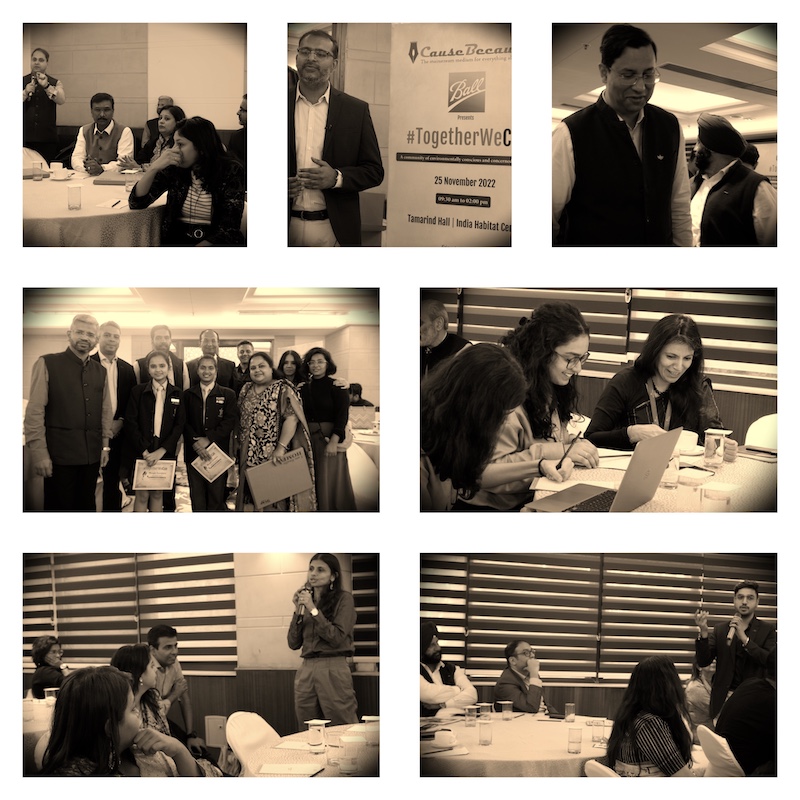The #TogetherWeCan Coffee Meet-up at India Habitat Centre (IHC), New Delhi, on 25 November 2022 served as a clarion call for individual action and partnerships, which also happens to be Goal No. 17 of the SDGs.
A focal point of the said partnerships is people everywhere, whether in their homes, at schools and colleges, at workplaces, and so on. The Meet-up, therefore, had representation from all of these places and spaces. Children and youth, teachers and researchers, executives from corporates and NGOs, social entrepreneurs and environment authorities such as United Nations Environment Programme (India) and Earth Day Network were keen and vocal participants in the conversations that took place at IHC.
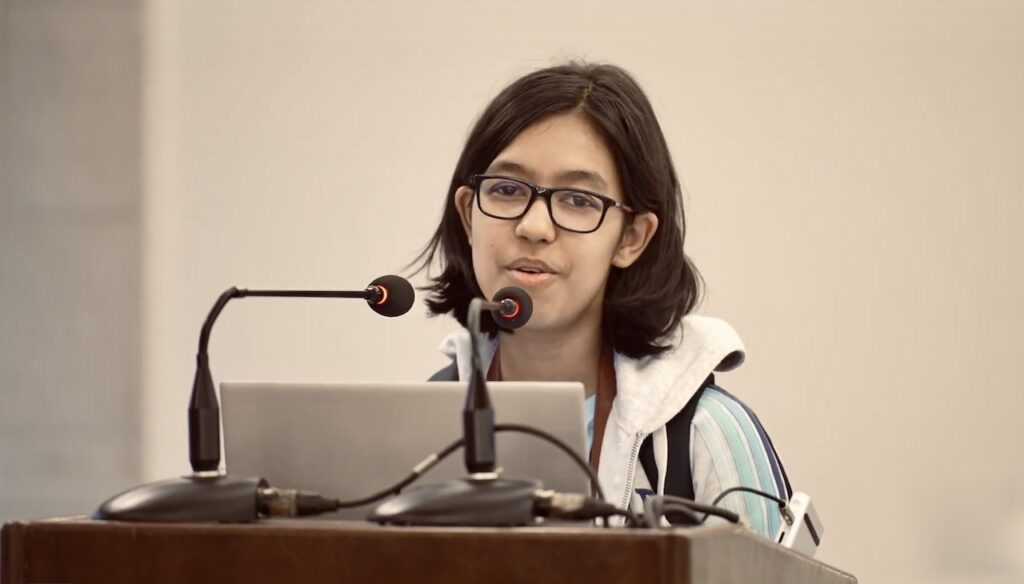 The Meet-up started with a reminder by 12-year-old Rayna, young thinker at CauseBecause, about ‘the need to change things around’ and that a middle ground does exist between being an ‘activist’ and being a ‘conscious’ person. She said – and quite correctly so – ‘we have to find this middle ground in which life continues and the world evolves, in a way that we aren’t destroying the earth more every second.’
The Meet-up started with a reminder by 12-year-old Rayna, young thinker at CauseBecause, about ‘the need to change things around’ and that a middle ground does exist between being an ‘activist’ and being a ‘conscious’ person. She said – and quite correctly so – ‘we have to find this middle ground in which life continues and the world evolves, in a way that we aren’t destroying the earth more every second.’
Introducing the TogetherWeCan community, Ranjan Rayna, co-founder and chief strategist, CauseBecause, said there was no room for cynicism in our fight to conserve what remained of our planet, to reverse the damage being done to its biodiversity, and to stick to the 1.5 degree target for global temperatures. The point of such a community is to negate the scepticism that ever so often takes hold of our minds when we feel we are fighting a lonely battle.
The question to be asked and introspected upon remains of course – which is, ‘are we doing enough to meet the climate challenge?’ That’s what Atul Bagai, Head, United Nations Environment Programme (UNEP) Country Office, India, reiterated in his message to the TogetherWeCan community, putting the individual and individual action in focus. Because ‘while governments and corporations can do a lot, individual behaviour will also make a lot of difference as far as the fight against climate change is concerned.’
As ‘sustainable consumption’ gains traction in the conversations on – and solutions being mooted for – environmental sustainability, Bagai hailed the timing of the global initiative ‘Lifestyle for the Environment – LiFE Movement’, which was recently launched in India by Prime Minister Narendra Modi. It basically ‘nudges human behaviour towards sustainability’. Ideas and suggestions are being invited from academics, universities, research institutions and other stakeholders on ways to influence and persuade individuals, communities and organisations across the world to adopt an environment-conscious lifestyle.
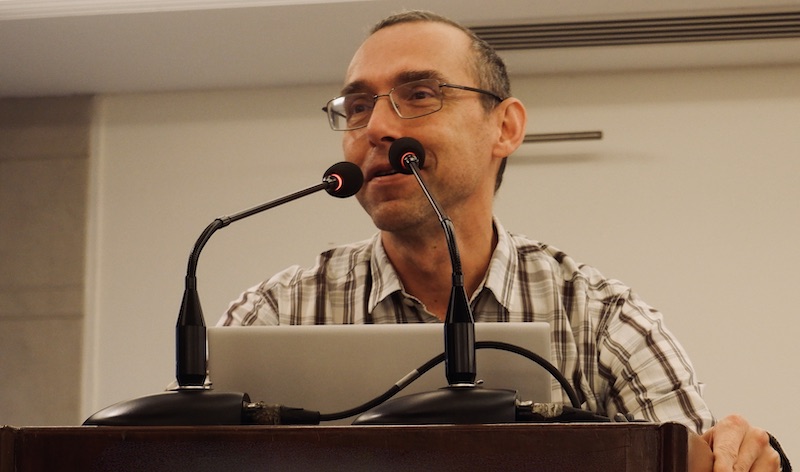
Dr Valentin Foltescu
That we are breathing air that is ’20 to 30 times more polluted than is acceptable’ should be a very compelling reason for us all to really take stock and take action at our end, said Dr Valentin Foltescu, Senior Science and Programme Management Officer in UNEP and the Climate and Clean Air Coalition’s Secretariat, in his lucid address to the gathering on a cold, crisp morning that would have been perfect for a conversation such as this, but for the fact that the air pollution was what it was. Not mincing his words”no point in doing that”Dr Foltescu said: ‘You all know that poor air quality is the number one environmental cause of shortened lives and various diseases. This is a complex challenge; it is not easy to get clean air. At the same time, actions that we may take in our institutions, in companies, and at individual level can play a major role in meeting this challenge. There is no technological barrier to air pollutants. In fact, we have plenty of traditional as well as innovative solutions that we need to finance, deploy and replicate at full scale. Air is a matter of life and of sustainability.’
UNEP works closely with governments of countries and also through partnerships, one of them being the Climate and Clean Air Coalition – Dr Foltescu said everyone should join in the efforts of the coalition to solve the problem ‘together’. Further, stating that sustainability can only be achieved though a ‘sustainable corporate sector’, he informed that the coalition has prepared a practical guide for businesses for assessing air pollutants emissions across the value chain.
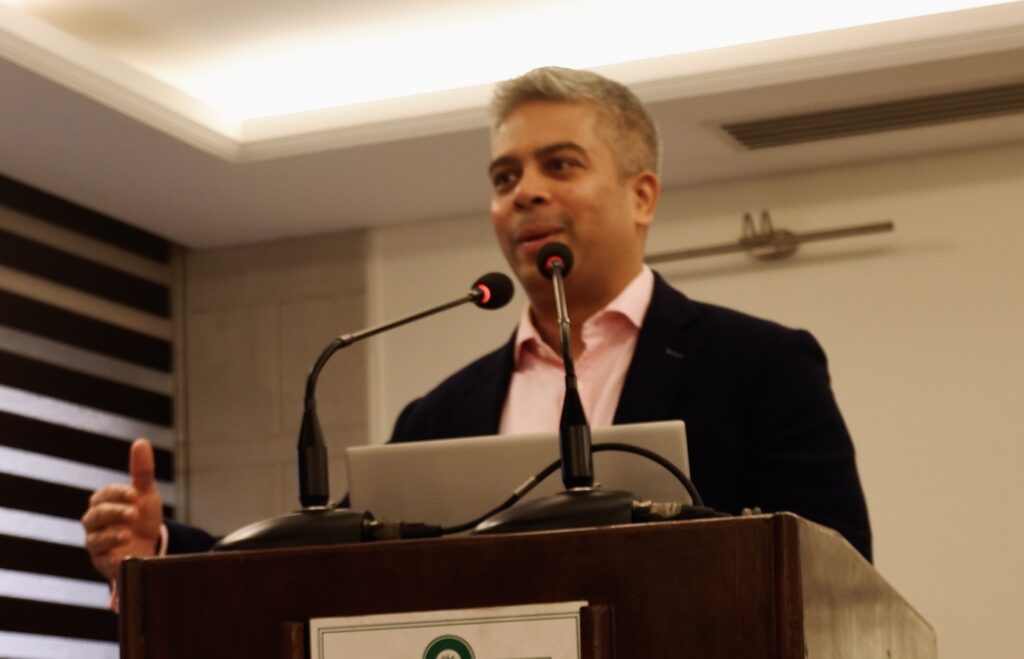
Amit Lahoti, Ball Corporation
A corporate state of mind
The ‘corporate perspective’ on sustainability, broad as the subject is, came from Amit Lahoti, senior commercial director & vice president, Beverage Packaging”Asia, Ball Corporation, as he spoke about the two pillars that his organisation rests on: product stewardship and societal impact. Defining product stewardship ‘as the right thing to do’ and explaining it in the context of Ball, Lahoti said it entailed doing away with manufacturing of products that were not sustainable. For example, Ball used to manufacture all kinds of packaging including plastic and glass, apart from aluminium, until they moved to aluminium exclusively, recognising that it was the most sustainable format.
Societal impact covers how the organisation addresses the needs and expectations of all stakeholders, including its employees. It was interesting that Lahoti should recall the recent spate of laying off of employees across tech companies, pointing out that employing young graduates and then laying them off in two years or five years is not the definition of sustainability from a societal point of view.
Not engaging in greenwashing”more rampant than one would expect”is another facet that Ball takes some pride in. Citing their reliance on science-based data for product lifecycle assessments, Lahoti said these are the kind of steps that companies should take to keep their sustainability commitment. Finally, with personal anecdotes and all, he said it was really about giving the right information to young minds and helping them develop the right attitude towards sustainability.
If you are looking for role models…
Right, young minds it is all about, because it’s true”said as it is ad infinitum”that they can provide the biggest push to the sustainability agenda. We can ignore them at our own peril.
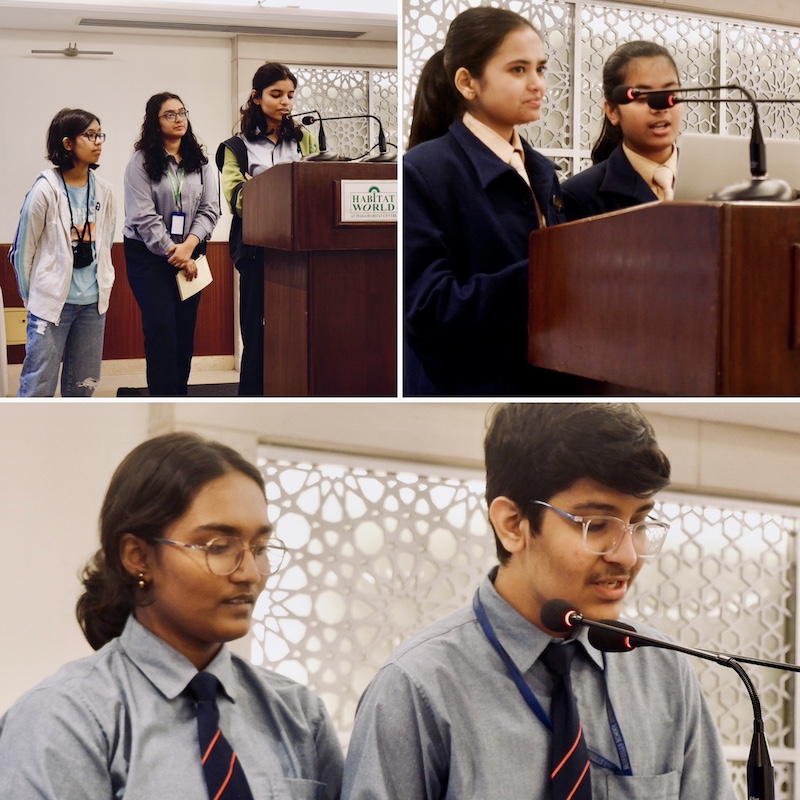 Watching the participating students from schools in Delhi-NCR (Tagore International School, East of Kailash; Bluebells School International, Kailash Colony; Shiv Nadar School, Noida) speak, one could see just how seriously they were doing their bit to help the earth breathe, the ‘small steps’ they said they were taking starting to add up beautifully. Examples: synthesising organic products in the school lab using indigenous resources or waste material, generating own electricity through rooftop solar panels (Tagore International School is not only able to meet all of its own energy demand, it also distributes the surplus among nearby areas), conserving water through rainwater-harvesting units and encouraging students to use water consciously, zero tolerance for polythene bags and single-use plastic, sending plastic to recyclers instead of landfills, practising mindful consumption, waste segregation (not easy to pull off when done at a certain scale), incorporating sustainable development aspects in classroom teaching methodology, partnering with local governance bodies and civil society. Dr Foltescu remarked that big and mid-sized companies should adopt a school each for scaling up the sustainability initiatives there.
Watching the participating students from schools in Delhi-NCR (Tagore International School, East of Kailash; Bluebells School International, Kailash Colony; Shiv Nadar School, Noida) speak, one could see just how seriously they were doing their bit to help the earth breathe, the ‘small steps’ they said they were taking starting to add up beautifully. Examples: synthesising organic products in the school lab using indigenous resources or waste material, generating own electricity through rooftop solar panels (Tagore International School is not only able to meet all of its own energy demand, it also distributes the surplus among nearby areas), conserving water through rainwater-harvesting units and encouraging students to use water consciously, zero tolerance for polythene bags and single-use plastic, sending plastic to recyclers instead of landfills, practising mindful consumption, waste segregation (not easy to pull off when done at a certain scale), incorporating sustainable development aspects in classroom teaching methodology, partnering with local governance bodies and civil society. Dr Foltescu remarked that big and mid-sized companies should adopt a school each for scaling up the sustainability initiatives there.
Describing the need for reframing thrifting as a sustainable and eco-friendly choice in the context of India (it’s still a less-known concept here), the students from Shiv Nadar School in Noida – they run a thrift store there – said that a thrift store ‘is not only about thoughtful consumption, it is also about poverty alleviation.’ They spoke about the ‘luxury of being able to spend less money over time’ – for example, a rich person able to spend, say, Rs 5,000 on a pair of boots will have something that will last them a long time; on the other hand, a poor person who manages to scrape together a couple of hundred rupees to buy a pair of shoes will most likely end up spending a similar amount every year to replace their shoes, which is not likely to last a long time. And this ‘luxury’ needs to be available to our most vulnerable communities – a thrift store can be a great enabler then.
Expounding on this train of thought, the students put forth some important aspects for the audience to take back with them. So, we know that consumerism has become a powerful symbol of contemporary capitalism and globalisation, and it is pushed into our consciousness by the constant marketing and advertising messages. Many youngsters’ social identity is established by ‘how they consume’. Knowing all this, it shouldn’t be that students are suddenly introduced to the idea of mindful, sustainable consumption – a mindset such as this is developed over time, through doing and imbibing, through knowing what one is doing, or what one is creating. It is equally important to know that one can have a tremendous amount of impact at the individual level, which is something worth pondering upon and valuing.
Representing Youth for Climate-India (they recently opened Asia’s first Climate Justice library in Delhi), a second-year Economics student from Delhi University said that individual action will have to be complemented by action at the community level as well as on the corporate front – and hence the relevance of converging at a meet-up such as this one. This sense of helping communities along informs the various initiatives that students from BML Munjal University engage in – they reach out to the nearby villages and enter into dialogues with the residents, helping them understand their environment better.
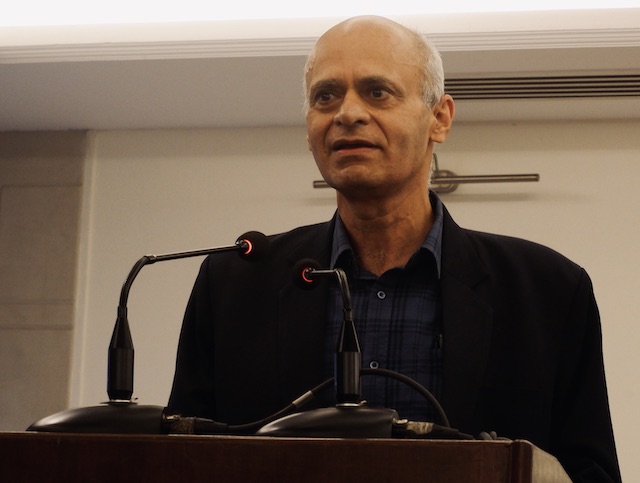 various measures they have undertaken to not only conserve the park’s biodiversity but also encourage staff members and visitors to understand and appreciate conservation in a holistic manner, so that these merge seamlessly with other aspects of their lives. Usage of ecofriendly material for setting up amenities (such as benches), not using plastic, making drinking water available so as to discourage people from carrying bottles, growing native plants and creating a roadmap for increasing the flora and fauna there, are those not-so-small steps that are contributing to the larger conservation story, with carbon sequestration and water recharging being great side benefits.
various measures they have undertaken to not only conserve the park’s biodiversity but also encourage staff members and visitors to understand and appreciate conservation in a holistic manner, so that these merge seamlessly with other aspects of their lives. Usage of ecofriendly material for setting up amenities (such as benches), not using plastic, making drinking water available so as to discourage people from carrying bottles, growing native plants and creating a roadmap for increasing the flora and fauna there, are those not-so-small steps that are contributing to the larger conservation story, with carbon sequestration and water recharging being great side benefits.
Do you know how much the consumption of resources globally is on an annual basis, asked Souvik Bhattacharjya, Associate Director, Integrated Policy Analysis Division, TERI, of all of us. It’s more than 95 billion tonnes as per 2020 estimates. China is the largest consumer of resources, clocking about 38 billion tonnes. India is next with 8 billion tonnes.
When it comes to sustainable production and consumption, one of the first things that needs to be understood is what resources, and how much, are being used. One can categorise these resources as metallic, non-metallic, energy, land, air, water and so on.
From the consumers’ perspective, one of the critical aspects that needs better understanding is sustainable packaging – is it aluminium, is it glass, is it Tetra Pak, or something else? This we cannot decide by looking at a little bit of information here and there. We have to look at the entire production-consumption value chain including the end-of-life management aspect – we can call this the cradle-to-cradle approach. Included in the lifecycle assessment of a product is its environmental footprint – accounting for factors such as greenhouse gas emissions, water consumption, ecological toxicity, and resource scarcity.
Take a 500ml aluminium can for reference – about 76 to 78 per cent of secondary aluminium is going into manufacturing this can. Basically, when you can use the 3 R’s – reduce, reuse, recycle – you are bound to get results. Interestingly, because aluminium is infinitely recyclable, you can bring the material back into the value chain again and again.
The thing then is: considering that such information, which can really drive sustainable production and consumption, is so important, how can we create more awareness? Can there be regulations to drive standards and labelling for this? Perhaps logos or marks that can be easily understood by consumers?
At the same time, this goes beyond awareness. Souvik spoke about the gap between awareness and consciously doing”or refraining from doing”something that has an impact on the environment. Awareness is a necessary condition but not a sufficient condition, he said, and pointed out what happens at the airport, for instance – it is common to see all kinds of discarded items lying mixed up in those three bins. For change to happen, it will have to be driven by the heart instead of just the mind.
A tree is not a tree unless…
When the session starring decision makers from corporate brands began, it started with the individual in focus. Specifically, what do these individuals do as their bit for the environment, beyond their roles of driving the CSR agenda of their respective organisations?
Facing the audience were: Brig. Rajiv Williams, Corporate Head – CSR, Jindal Stainless; Dr Nidhi Pundhir, Vice President and Director, HCL Foundation; Juhi Gupta, Head – Sustainability, PepsiCo Holdings India; Ganesh Kaliyaperumal, Senior General Manager, Corporate Affairs, Communications & Sustainability, Bisleri International; and Dipanwita Chakraborty, Regional Director, Corporate Responsibility & Sustainability, Cargill, Asia Pacific.
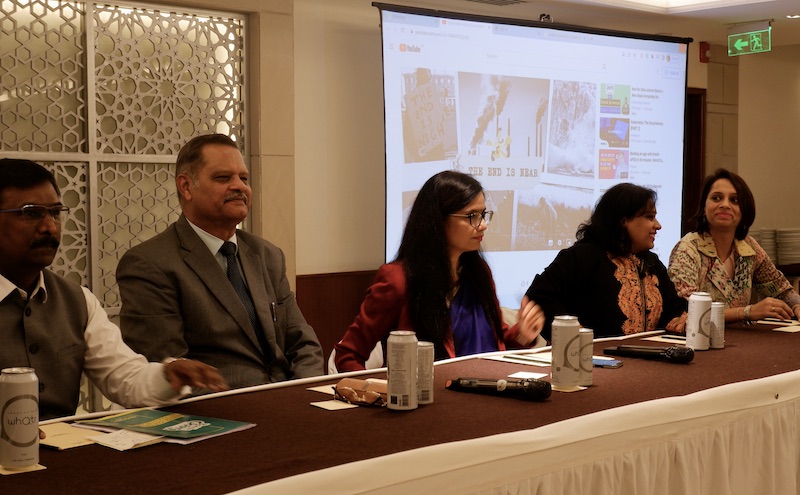
From left to right: Ganesh Kaliyaperumal, Bisleri International; Brig. Rajiv Williams, Jindal Stainless; Dr Nidhi Pundhir, HCL Foundation; Juhi Gupta, PepsiCo Holdings India; and Dipanwita Chakraborty, Cargill – Asia Pacific
Dr Pundhir, just back from COP-27 hosted in the Egyptian coastal city of Sharm el-Sheikh, said that the concern for the planet ‘is almost a state of emergency’, and this is one debate where there is no ‘against’. The issue though is ‘how much do we understand sustainability’. There’s (more than) a bit of disconnect in how everyone is approaching it, in forming a larger consensus on what needs to be done, as an individual, as a family, a community, a corporate, and so on. Dr Pundhir used the metaphor of the elephant to explain how everyone is seeing different parts of the one and the same thing.
It is easy to understand sustainability when we look at ourselves as part of the larger eco system, instead of approaching it as consumers. In fact, it is easy to do it when we live sustainably everyday. No effort is small, because as much as we are part of the problem, we are also part of the solution.
Personal anecdotes enlivened the conversations as much as they put so many things in perspective, not the least being how sustainability has always been part of our ‘value system’ here in India. You remember that you were not allowed to waste the food on your plate? Up until our parents’ or grandparents’ generation, food going into the dustbin was unheard of, or in any case not allowed to happen.
Partnerships and harnessing the power of communities are needed to drive the sustainability agenda, and this aspect came out loud and clear in the real stories that were told inside that hall on a beginning-to-be-cold winter morning in Delhi. The air quality is starting to deteriorate, as it does every winter now, and how much we need these stories cannot be emphasised enough. So that we listen to these stories and know that there are all these other possibilities.
There is the true story about how sparrows are coming back to town. Back in 2008, environmentalist Rakesh Khatri started making nests for sparrows, initially on his own and then with children everywhere. In that first year he made 20 nests – it took about 4 days for the first nest to be adopted by a sparrow. Since then, he has made more than 400,000 nests”and counting. Often referred to as the Nest-man of India, he says people tend to ask why they should make the nests – shouldn’t the birds be doing that? Well, have we left them any space in our urban jungles?
Other stories are happening too. Listen to PepsiCo telling us that they are taking back the plastic and other waste discarded by us and repurposing these into benches and chairs, which are then given to local municipal bodies to be put in parks and other public spaces – Cargill telling us the story of how they guided and assisted about 2,500 women in a water-stressed geography of Karnataka in reaping the benefits of homestead farming using ecologically viable resources – HCL Foundation talking about their happy collaboration with the same Nest-man mentioned above, this being among their several initiatives focused on bringing about positive behavioural change among people with regard to practising sustainability as a way of life.
Talking about birds, nests, the lack of space, the diminishing greenery, and suchlike, Dr Pundhir reminds us that a tree is not a tree unless birds come to roost there or make nests there. One tree is an institution. It’s certainly not about just planting those saplings – unless they survive, it’s nothing more than a vacuous exercise. Unless native species of flora and fauna survive and flourish, a tree-planting programme cannot be deemed a success.
As the mic changed hands that day, it was clear that conversations around and about sustainability cannot be linear – one thing will lead to another, and another, and suddenly someone will be reminded of something that used to happen a certain way in the not-so-distant past, telling us that sustainability was just how it was back then, until it wasn’t. So there is nostalgia, and questions and introspections, and the desire to do something that is more than a bit, because that suddenly feels like a cliché. Perhaps that’s what happens when one is in a roomful of doers – people who mean what they say and do what they mean.
These individuals – some social entrepreneurs, some CSR and sustainability practitioners – helped connect the dots in the conversations: Robin Sarkar, Director – Education, Shiv Nadar Foundation; KK Upadhyay, Chairperson, Centre for Sustainability & CSR, BIMTECH; Karuna Singh, Regional director – South Asia & Country Director – India, Earth Day Network; Shantanu Das Gupta, Head – Community Operations, Dr. Shroff’s Charity Eye Hospital; Dr Ruby Makhija, Director, Why Waste Wednesdays Foundation; Ankur Chawla, CEO, Responsible Whatr; Rohit Sharma, CEO, PURP; Gurbirender Singh Gill, Director – Development & Alumni Relations, BML Munjal University; Lakhbir Singh, President, Adarsh Yuva Samiti; Pranav Poddar, Director Syenergy Environics; and Tulika Sanadhya, Nitin Sharma, Kishan Pesswani, and Mansi Thapliyal, Aritram, a Waldorf-inspired school.
And we all called it a day with no particular parting thoughts – just that something felt right, because we knew we were not exactly alone in this trying to do what is good and right for the planet (‘good for us’ is included in this). The very least one can do!
